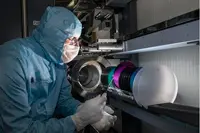 Researchers at the University of Southampton's Zepler Institute say they have used ambient pressure chemical vapour deposition to fabricate large area 2D films of molybdenum disulphide (MoS2). The team says the room temperature process, which is scalable to any size wafer, could pave the way for the large-scale manufacture of devices such as flexible and transparent optoelectronics, gas sensors, memory devices and photovoltaics.
Researchers at the University of Southampton's Zepler Institute say they have used ambient pressure chemical vapour deposition to fabricate large area 2D films of molybdenum disulphide (MoS2). The team says the room temperature process, which is scalable to any size wafer, could pave the way for the large-scale manufacture of devices such as flexible and transparent optoelectronics, gas sensors, memory devices and photovoltaics.
MoS2 – which can detect and emit light and which has high carrier mobility – has only been available commercially in small flakes. "Using flakes of MoS2, which are typically only a few hundred square microns in area, to make devices is impractical, time-consuming and inefficient and does not provide a practical route to rapid prototyping and existing semiconductor fabrication protocols, said Dan Hewak, professor of optoelectronics at the Zepler Institute. "For these new materials to be adopted in mainstream electronics, they must be compatible with the semiconductor processing lines used in the mass production of electronic chips.
"Our expertise in novel thin-film fabrication, coupled with our ultra-high purity raw material processing facility, has enabled us to purify and synthesise large area films to a consistency and purity level not available commercially."
By processing initially at room temperature, rather than at the high temperatures typically used, the team says it is possible to deposit MoS2 on a wider range of substrates, including those with low thermal stability like flexible displays. The technique also minimises stress on other previously deposited layers and helps reduce processing costs.
"We have also developed a technique for lifting these large-area films off the substrate they were grown on and depositing them onto a different substrate," said Prof Hewak. "This means the films can be put onto any material, opening up entirely new applications."
Author
Graham Pitcher
Source: www.newelectronics.co.uk

